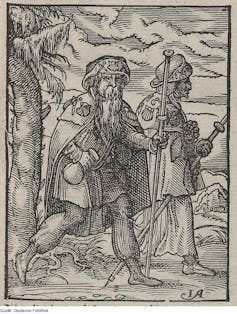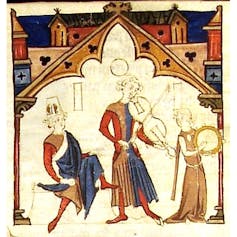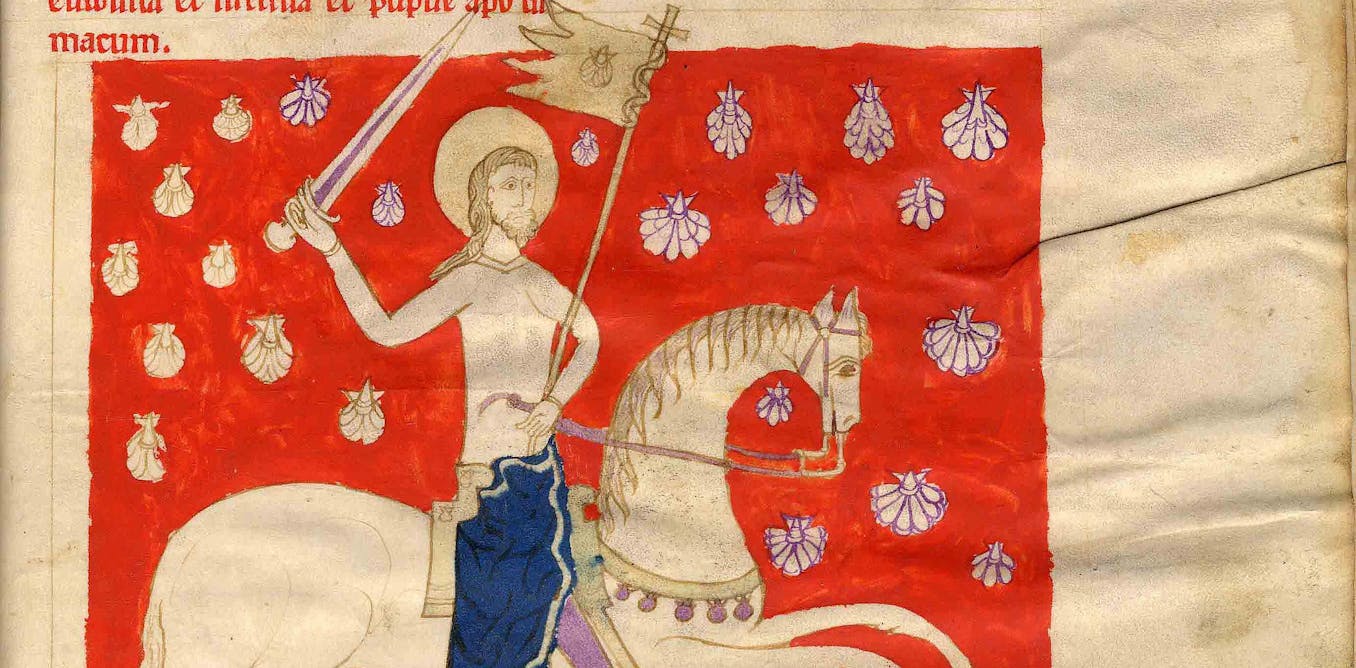Situated at the end of the Camino de Santiago pilgrimage route – known in English as St. James’ Way, or simply “the Camino” – the Galician city of Santiago de Compostela is constantly filled with pilgrims who have completed their journeys.
More recently, there is also a growing mass of so-called “tourgrims”, who visit the city throughout the year to do little more than take a selfie from cathedral’s roof and picnic inconsiderately in front of the cathedral. They may even travel to the nearby Atlantic coast to symbolically burn their boots and leave rags (and piles of rubbish) as evidence of their trip to the end of the world.
The spirit of these tourists – who travel in comfort and often send their bags in advance via luggage service – is far removed from the meaning of pilgrimage proclaimed in the Veneranda dies, one of the best known and most studied texts of the Codex Calixtinus: “the pilgrimage route is a very good thing, but it is narrow. For narrow is the path that leads man to life: on the other hand, wide and spacious is the one that leads to death.”
Nevertheless, these psueudo-pilgrims remain close to the etymological meaning of the term “pilgrim”: one who travels through other lands, far from home, as a foreigner.
Read more:
Want to walk the Camino de Santiago pilgrimage? Leave your phone at home
Jerusalem, Rome, Santiago
Although in the Middle Ages there was already a significant network of mainly local shrines, the preferred international destinations for pilgrims were initially Jerusalem and Rome, and then later Santiago de Compostela, situated in Galicia, at the western end of the known world.
Wikimedia Commons
In a passage from the 1294 text Vita Nova, Dante Alighieri explained that a “pilgrim” was someone who travelled to Galicia because, among the Apostles, the tomb of St. James was the furthest from his homeland. Those who travelled to Jerusalem and Rome were instead known as “palmers” and “romers”, respectively. However, texts from the period show that this terminological distinction was not always applied so rigidly in practice.
Beyond the spiritual and devotional, there were plenty of other motives to take a pilgrimage the Middle Ages. Some travellers were motivated by simple curiosity and a desire for knowledge. Pilgrimage was also imposed as a civil penalty for committing a crime (although, over time, it could be commuted to financial compensation), and it was even possible to make a pilgrimage on behalf of another person.
In any case, pilgrims came to enjoy special consideration, protected by specific laws. Pilgrimage also came to play a part in redemption – from the 11th to 12th centuries onwards, they took on a new significance when the first indulgences were granted to those who had taken part in the Crusades.
Nevertheless, medieval pilgrims were not immune to braggadocio, or to exaggerating and bending the truth about their own journeys. Some of these “pilgrims” were even the target of jokes and criticism, and ended up immortalised in literary texts from the period.
Perspectives on pilgrimage
Slogans and songs to persuade the population to undertake a pilgrimage have always existed, and literature provides many examples. In Occitan lyric poetry, the troubadour Marcabru is considered the inventor of the cansó de crozada, a type of composition that developed during the Crusades.
The “cantigas” of the Galician-Portuguese troubadours are different, and took many different forms. The “cantigas de santuario”, as they were known, promoted chapels, mainly local ones, but there are others dedicated to the Compostela pilgrimage of Sancho IV and, further afield, others focused on themes related to the Holy Land, forgiveness, and false pilgrims.
The cantigas often approached these subjects from a critical, satirical perspective. In the absence of modern-day social media, they offer us a snapshot of what popular opinion looked like the 13th century.
A medieval “tourgrim”?

Deutsche Fotothek
Galician minstrel Pero d’Ambroa, a member of Alfonso X’s literary circle, shamelessly boasted about an overseas journey that many knew he could never have completed.
In response, a group of prominent troubadours wrote a series of satirical songs that exposed this false pilgrim. They accused him of half-heartedly carrying out the crusade, surrounding himself with luxury, and lying about his journey.
This is denounced in the verses of Pedr’Amigo de Sevilha, who reported that d’Ambroa went to “dwell in the best street he could find”. Pero Gomez Barroso was even more scathing – he claimed not to have dedicated any cantiga to the subject because the journey was impossible, but threatened to bring other matters to the court’s attention that could have left the false traveller in a very bad situation.
With the controversy out in the open, Pero d’Ambroa defended himself against the accusations, but his efforts to defend his honour and reaffirm the authenticity of his journey only contributed to the satirical dialogue.
A knight’s impossible journey
The case of Pero d’Ambroa is far from exceptional – a knight by the name of Sueiro Eanes also attracted the satirical ire of troubadour Martín Soares for his tales of an unlikely pilgrimage to the Holy Land.
In his song, Martín Soares attacks the knight by pointing out geographical inaccuracies, impossible timings, and the inconsistency of his itinerary. With more than a hint of mockery, Soares suggested that the French city of Marseille was beyond the sea, while Acre (in the Kingdom of Jerusalem) was in fact closer, and located near the Pyrenean town of Somport.
He also suggests that, after visiting different parts of the Iberian Peninsula, Sueiro Eanes could continue his journey from the Portuguese town of Nogueirol and spend the night in Jerusalem.
The pilgrim’s baggage

Wikimedia Commons
Today we may scorn pilgrims who travel with luggage service, but Alfonso X’s literary circle also highlighted “baggage” of a different kind, such as that carried by María Pérez, the soldadeira also known as Balteira.
Her proximity to Alfonso’s troubadours led several of them to dedicate satirical songs to what was seen as her life of “loose morals”. Among the texts of the satirical cycle of La Balteira, the verses of the troubadour Pero da Ponte stand out for their double entendres: as a crusader, María returned from the Holy Land laden with forgiveness, but little by little, she lost it by spending her nights with young men. In da Ponte’s analogy, forgiveness and redemption had to be kept safe, but María’s “baggage” apparently had no lock.



